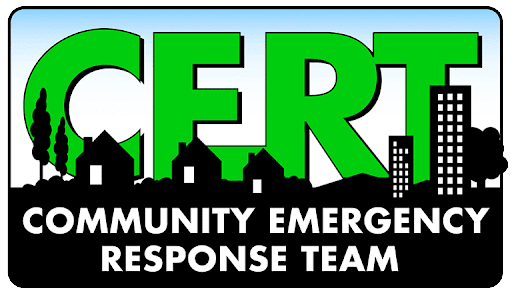| Unit 1 |
Disaster Preparedness - Learn about
- Roles and Responsibilities for Community Preparedness - How everyone in a community has a role in disaster preparedness and response.
- Role of CERTs - CERT organization, disaster and non-disaster roles, and laws that protect disaster workers from liability.
- Elements of Disasters and Their Impact on Infrastructure - The potential effect on electrical service, telephone communication, availability of food, water, shelter and fuel, and emergency services.
- Personal and Organization Preparedness - How to prepare in advance to improve the quality of your survival and to reduce damage from hazards.
|
 |
| Unit 2 |
CERT Organization - Learn about:
- CERT Organization - How to organize and deploy CERT resources according to CERT organization principles.
- CERT Size-Up - How to conduct the continual data-gathering and evaluation process at the scene of a disaster or emergency.
- Rescuer safety - How to protect your own safety and your buddy's during search and rescue..
- Documentation - Strategies for documenting situation and resource status.
|
 |
| Unit 3 |
Disaster Medical Operations - Part 1 - Learn about: Assisting Disaster Medical Operations - How to assist by controlling bleeding, maintaining normal body temperature, opening an airway, providing comfort to patients, and applying basic first aid care for a number of injuries.
Additional information
|
 |
| Unit 4 |
Disaster Medical Operations - Part 2 - Learn about:
- Mass Casualty Incidents: How to assist first responders in responding to mass casualty incidents.
- Functions of Disaster Medical Operations - What the five major functions of disaster medical operations are and how they are set up.
- Disaster Medical Treatment Areas - How to establish them and what their functions are.
- Head to Toe Assessment- How to perform a head-to-toe assessment to identify and treat injuries.
- Public Health Considerations - How to maintain hygiene and sanitation.
Additional information
|
 |
| Unit 5 |
Disaster Psychology - Learn about:
- Disaster Psychology - The psychological impact of a disaster on rescuers and victims and how to provide "psychological first aid".
- Caring for Yourself, Your Buddy, and Survivors - Steps volunteers can take individually and as part of a CERT before, immediately following, and after a disaster.
Additional information:
|

|
| Unit 6 |
Fire Safety - Learn about:
- Fire Chemistry - How fire occurs, classes of fire, choosing the correct means to extinguish each type of fire.
- Fire Size-Up Considerations - How to evaluate fires, assess firefighting resources and determine a course of action.
- Portable Fire Extinguishers - types of portable fire extinguishers and how to operate them.
- Fire Suppression Safety - how to decide if you should attempt to extinguish a fire; how to approach and extinguish a fire safely.
- Hazardous Materials - How to identify potentially dangerous materials in storage, in transit and in your home.
- Fire and Utility Hazards - How to identify potential fire and utility hazards in your home and workplace; how to implement successful fire prevention strategies.
|
 
|
| Unit 7 |
Light Search and Rescue Operations - Learn about:
- Search and Rescue Size-Up - How to size up the situation in which the search and rescue teams will operate
- Conducting Interior and Exterior Search Operations - How to search systematically for disaster victims
- Conducting Rescue Operations - Safe techniques for lifting, leveraging, cribbing, and victim removal
|
 |
| Unit 8 |
Terrorism - Learn about:
- Terrorism - Defining terrorism, including the goals and tactics of some terrorist groups, and detailing how to respond when an active shooter is in your vicinity.
- Eight Signs of Terrorism - The eight signs of terrorism and how to report suspicious activity.
- Preparing for Your Neighborhood - Steps to take to be prepared at home, work and in your neighborhood.
- Hazmat and CBRNE (Chemical, Biological, Radiological, Nuclear, high-yield Explosives) - Identifying some basic guidelines during a Hazmat or CBRNE event.
|
 |
| Final Disaster Drill |
Course Review and Disaster Simulation - "Learn by doing" exercises that put knowledge, skills and abilities gained in the course into practice - teams will be formed for a series of simulations:- Fire safety - extinguishing small fires
- Medical triage - conducting triage evaluations and sorting of victims (green, yellow, red and black)
- Medical operations - conducting patient evaluation with basic treatment
- Search and rescue - practicing cribbing techniques
- Radio communications - practicing communicating with the incident command and other teams working in the area
- Conducting an "after action review" to share things that went well and things that could be improved
Check out this quick video of the 2022 Fall CERT Final Disaster Simulation activities,
|
 |
| Unit 9 |
Next steps and other opportunities - Learn about:- Review of key points from the course with a final "exam"
- Awarding of CERT certificates
- How to become more involved with Issaquah CERT emergency worker or volunteer
|
 |












